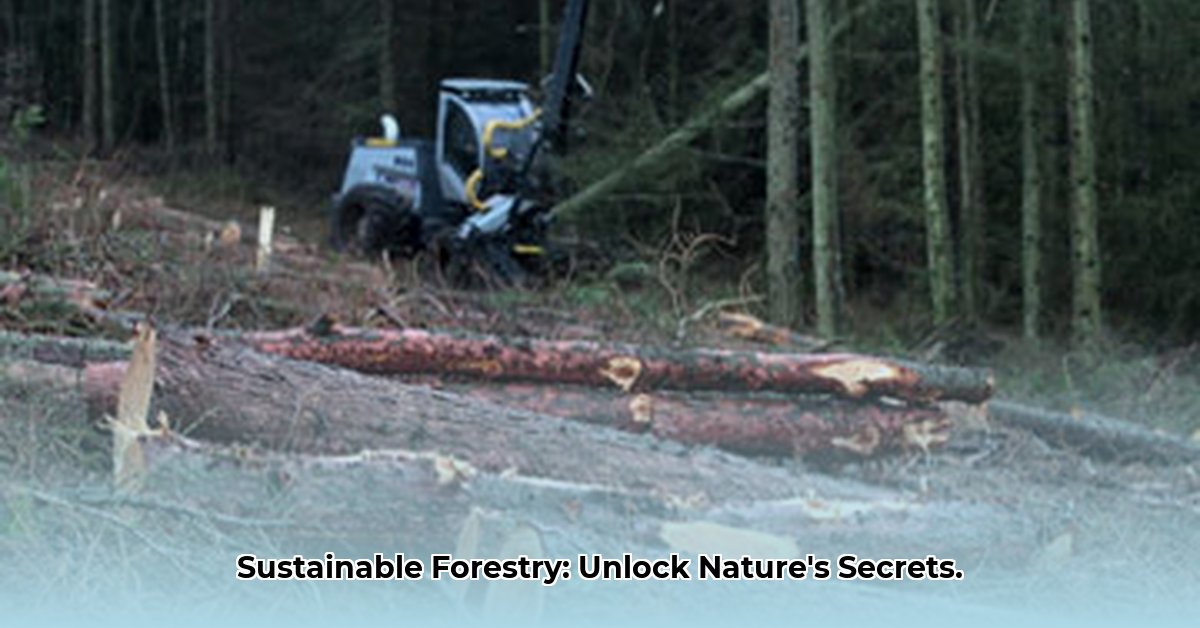
Understanding Sustainable Forestry: A Long-Term Vision
Our forests are vital ecosystems, providing clean air, water, and countless resources. However, unsustainable logging practices threaten their health and the planet's future. Sustainable forestry, in contrast, prioritizes long-term forest health and productivity, ensuring benefits for current and future generations. It's about finding the balance between resource extraction and ecological preservation. How can we ensure a sustainable future for our forests? For deeper insights into tree species, check out this detailed study.
This guide provides a comprehensive framework for implementing responsible logging practices, incorporating ecological, economic, and social considerations. We will explore key techniques, address common challenges, and highlight the importance of collaborative efforts. Did you know that sustainably managed forests can sequester significant amounts of carbon dioxide, mitigating climate change?
The Core Principles of Sustainable Forestry
Sustainable forestry hinges on several crucial principles:
- Long-term planning: Sustainable forestry isn't a quick fix; it demands a long-term perspective, considering the future implications of current practices.
- Ecological integrity: Protecting biodiversity and maintaining the forest's overall health is paramount. A diverse forest is more resilient to environmental changes.
- Community engagement: The success of sustainable forestry relies on the active participation and collaboration of local communities. Their traditional knowledge and understanding of the forest are invaluable.
- Economic viability: Sustainable forestry practices must be economically sound, ensuring the industry's long-term viability and supporting the livelihoods of those who depend on it.
Key Practices for Responsible Logging
Implementing sustainable forestry involves a multifaceted approach. Let's delve into the essential practices:
Reduced-Impact Logging (RIL): RIL minimizes damage to the surrounding ecosystem during logging operations. This precision approach prioritizes careful planning of logging routes and methods to preserve the forest’s structure and biodiversity. Studies show that RIL can significantly reduce soil erosion and habitat disruption.
Selective Cutting: Instead of clear-cutting, selective cutting targets only mature trees, leaving younger trees to grow. This method preserves the forest's structure, enhances biodiversity, and promotes long-term forest health. Selective cutting helps maintain a more natural forest ecosystem.
Reforestation and Afforestation: Replanting harvested areas (reforestation) and establishing new forests in deforested areas (afforestation) are crucial for restoring forest cover, enhancing carbon sequestration, and improving biodiversity. Efficient reforestation programs can boost forest growth by up to 90%.
Community Involvement: Engaging local communities in forest management is vital. Their traditional ecological knowledge, coupled with their economic dependence on the forest, makes their participation essential for successful, long-lasting sustainable forestry. Community-based forest management often leads to improved forest health and greater economic benefits for local people.
Forest Certification: Certifications from organizations like the Forest Stewardship Council (FSC) demonstrate commitment to sustainable practices. Certification schemes provide a framework for responsible management and promote transparency. FSC certification can enhance market access and improve brand reputation.
A Step-by-Step Guide to Sustainable Forest Management
Implementing sustainable forestry requires a structured approach:
Comprehensive Forest Assessment: A thorough assessment of the forest's ecological features, including species composition, soil conditions, and biodiversity, is the foundation of a successful management plan. This phase also involves understanding the forest's social and economic context.
Developing a Tailored Management Plan: The assessment informs the development of a detailed management plan that outlines specific objectives, methodologies, and monitoring strategies. Community participation is essential in this stage.
Implementation and Monitoring: The management plan is then implemented, with regular monitoring to track progress, identify challenges, and make necessary adjustments. Data collection includes ground surveys, remote sensing, and community feedback.
Evaluation and Adaptation: Regular evaluation of the plan's effectiveness ensures ongoing improvement. Evaluation involves analyzing data, incorporating stakeholder feedback, and adapting strategies to maintain sustainability. Adaptive management is key to long-term success.
Leveraging Technology for Enhanced Sustainability
Technology plays a vital role in enhancing sustainable forestry practices:
- Satellite imagery: Real-time monitoring of deforestation helps combat illegal logging and enables rapid responses to environmental threats.
- Blockchain technology: Improved transparency in the supply chain ensures responsible sourcing of timber and reduces opportunities for illegal logging.
Addressing Key Challenges in Sustainable Forestry
Sustainable forestry faces several challenges:
| Challenge | Mitigation Strategies |
|---|---|
| Illegal Logging | Strengthened law enforcement, community-based monitoring, technological advancements in tracking and surveillance. |
| Climate Change Impacts | Adaptation strategies, including species selection, improved forest management for climate resilience. |
| Lack of Community Support | Active community engagement, fair benefit-sharing mechanisms, fostering collaborative management approaches. |
| Inadequate Funding | Public-private partnerships, sustainable finance mechanisms, and investment in research and development. |
| Competing Land Uses | Integrated land-use planning, conservation easements, promoting sustainable agriculture. |
Dr. Anya Sharma, Director of Forest Conservation at the Global Environmental Institute, emphasizes: "Sustainable forestry isn't just about trees; it's about resilient ecosystems, thriving communities, and a healthy planet. By working collaboratively, we can achieve a balance that benefits all."
Measuring Success: Key Performance Indicators (KPIs)
Tracking Key Performance Indicators (KPIs) is crucial for measuring the success of sustainable forestry initiatives. These KPIs should encompass financial, environmental, and social aspects:
- Financial KPIs: Net profit margin, return on investment (ROI), cost per hectare managed.
- Environmental KPIs: Carbon sequestration rate, sustainable harvesting rate, biodiversity indicators, water quality.
- Social KPIs: Community involvement, worker safety, and equitable benefit-sharing.
Regular review and adjustment of KPIs are essential for continuous improvement and adaptation to changing circumstances. Aligning KPIs with industry standards, such as the Sustainable Forestry Initiative (SFI) 2022, further enhances transparency and accountability.
Successfully implementing sustainable forestry requires a holistic approach, integrating ecological, economic, and social considerations. By embracing innovative technologies and working collaboratively, we can secure the long-term health of our forests for future generations.